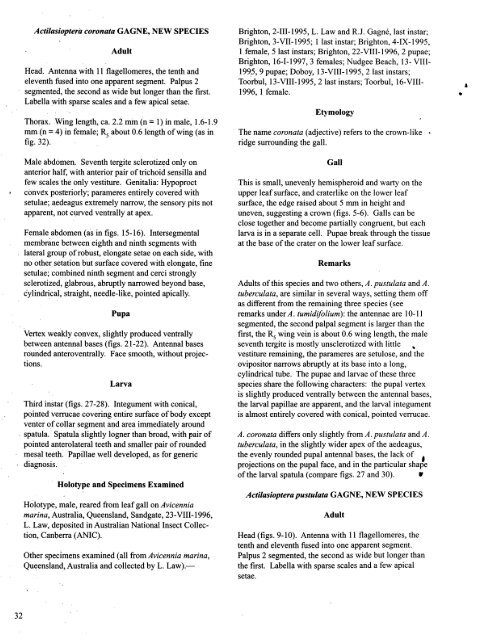il ' ii - Northern Research Station - USDA Forest Service
il ' ii - Northern Research Station - USDA Forest Service
il ' ii - Northern Research Station - USDA Forest Service
You also want an ePaper? Increase the reach of your titles
YUMPU automatically turns print PDFs into web optimized ePapers that Google loves.
Act<strong>il</strong>asiopter a coronata GAGNE, NEW SPECIES Brighton, 2-III-1995, L. Law and R.J. Gagnr, last instar;<br />
. Brighton, 3-VII-1995; 1 last instar; Brighton, 4-IX-1995,<br />
Adult 1 female, 5 last instars; Brighton, 22-VIII-1996, 2 pupae;<br />
Brighton, 16-I- 1997, 3 females; Nudgee Beach, 13- VIII-<br />
Head. Antenna with 11 flagellomeres, the tenth and 199.5, 9 pupae; Doboy, 13-VIII-1995, 2 last instars;<br />
eleventh fused into one apparent segment. Palpus 2 Toorbul, 13-VIII-1995, 2 last instars; Toorbul, 16-VIII- A<br />
segmented, the second as wide but longer than the first. 1996, 1 female. ,,<br />
Labella with sparse scales and a few apical setae.<br />
Etymology<br />
Thorax. Wing length, ca. 2.2 mm (n = 1) in male, 1.6-1.9<br />
mm(n = 4) in female; R5 about 0.6 length of wing (as in The name coronata (adjective) refers to the crown-like •<br />
fig. 32). ridge surrounding the gall.<br />
Male abdomen, Seventh tergite sclerotized only on Gall<br />
anterior half, with anterior pair of trichoid sens<strong>il</strong>la and<br />
few scales the only vestiture. Genitalia: Hypoproct This is small, unevenly hemispheroid and warty on the<br />
, convex posteriorly; parameres entirely covered with upper leaf surface, and craterlike on the lower leaf<br />
setulae; aedeagus extremely narrow, the sensory pits not surface, the edge raised about 5 mm in height and<br />
apparent, not curved ventrally at apex. uneven, suggesting a crown (figs. 5-6). Galls can be<br />
close together and become partially congruent, but each<br />
Female abdomen (a_sin figs. 15-16). Intersegmental larva is in a separate cell. Pupae break through the tissue<br />
membrane between eighth and ninth segments with at the base of the crater on the lower leaf surface.<br />
lateral group of robust, elongate setae on each side, with<br />
no other setation but surface covered with elongate, fine Remarks<br />
setulae; combined ninth segment and cerci strongly<br />
sclerotized, glabrous, abruptly narrowed beyond base, Adults of this species and two others, A. pustulata and A.<br />
6ylindrical, straight, needle-like, pointed apically, tuberculata, are sim<strong>il</strong>ar in several ways, setting them off<br />
as different from the remaining three species (see<br />
Pupa remarks underA. tumidifolium)" the antennae are 10-11<br />
segmented, the second palpal segment is larger than the<br />
Vertex weakly convex, slightly produced ventrally first, the R5wing vein is about 0.6 wing length, the male<br />
between antennal bases (figs. 21-22). Antennal bases seventh tergite is mostly unsclerotized with little<br />
rounded anteroventrally. Face smooth, without projec- vestiture remaining, the parameres are setulose, and the<br />
tions, ovipositor narrows abruptly at its base into a long,<br />
cylindrical tube. The pupae and larvae of these three<br />
Larva species share the following characters: the pupal vertex<br />
is slightly produced ventrally between the antennal bases,<br />
Third instar (figs. 27-28). Integument with conical, the larval pap<strong>il</strong>lae are apparent, and the larval integument<br />
p0inted verrucae covering entire surface of body except is almost entirely covered with conical, pointed verrucae.<br />
venter of collar segment and area immediately around<br />
spatula, Spatula slightly logner than broad, with pair of A. coronata differs only slightly from A. pustulata and A.<br />
pointed anterolateral teeth and smaller pair of rounded tuberculata, in the slightly wider apex of the aedeagus,<br />
mesal teeth. Pap<strong>il</strong>lae well developed, as for generic the evenly rounded pupal antennal bases, the lack of<br />
. diagnosis projections on the pupal face, and in the particular shaple<br />
' of the larval spatula (compare figs. 27 and 30).<br />
Holotype and Specimens Examined<br />
ActUasioptera pustulata GAGNE, NEW SPECIES<br />
H0!otype, male, reared from leaf gall on Avicennia<br />
marina, Australia, Queensland, Sandgate, 23-VIII- 1996, Adult<br />
L. Law, deposited in Australian National Insect Collection,<br />
Canberra (ANIC). Head (figs. 9-10). Antenna with 11 flagellomeres, the<br />
tenth and eleventh fused into one apparent segment.<br />
Other specimens examined (all from Avicennia marina, Palpus 2 segmented, the second as wide but longer than<br />
Queensland, Australia and collected by L. Law). the first. Labella with sparse scales and a few apical<br />
setae.<br />
32<br />
.
















